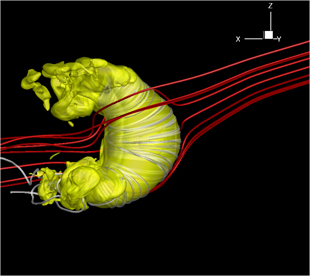A New View of the Solar System: Astrophysical Jets Driven by the Sun
The magnetic field of the sun plays a crucial role in shaping the heliosphere—the domain of the sun—by accelerating the solar wind into a pair of jets
As the sun skims through the galaxy, it flings out charged particles in a stream of plasma called the solar wind. The solar wind creates a bubble, known as the heliosphere, which extends far outside the solar system. For decades, scientists have visualized the heliosphere as comet-shaped, with a very long tail extending thousands of times farther than the distance from the Earth to the sun.
 New research suggests that the sun’s magnetic field controls the large-scale shape of the heliosphere much more than expected. A new model, described in a paper published Feb. 19, 2015 in the journal Astrophysical Journal Letters, shows that the magnetic field squeezes the solar wind along the sun’s north-south axis, producing two jets. These jets are then dragged downstream by the flow of the interstellar medium—the gases and dust that lie between star systems.
New research suggests that the sun’s magnetic field controls the large-scale shape of the heliosphere much more than expected. A new model, described in a paper published Feb. 19, 2015 in the journal Astrophysical Journal Letters, shows that the magnetic field squeezes the solar wind along the sun’s north-south axis, producing two jets. These jets are then dragged downstream by the flow of the interstellar medium—the gases and dust that lie between star systems.
The model indicates that the heliospheric tail doesn’t extend to large distances but is split into two jets, with a form similar to astrophysical jets observed in many other stars and around black holes. This new understanding of the heliosphere could have implications for future attempts at interstellar travel.
“Jets are really important in astrophysics,” said James Drake, Distinguished University Professor of physics and director of the Joint Space-Science Institute at the University of Maryland. “From what we can tell, the mechanism that’s driving these heliospheric jets is basically the same as it is in, for example, the Crab Nebula. Yet this is really close by. If we’re right about all of this, it gives us a local test bed for exploring some very important physics.”
Drake suggests picturing a tube of toothpaste with rubber bands wrapped around it. In this case, the toothpaste is the jets’ plasma, and the rubber bands are the rings of the solar magnetic field.
“Magnetic fields have tension just like rubber bands, and these rings squeeze in. So imagine you wrap your toothpaste tube very tightly with a lot of rubber bands; they will squeeze the toothpaste out the end of your tube,” said Drake, who also has appointments in the UMD Institute for Physical Science and Technology and the Institute for Research in Electronics and Applied Physics.
The new view of the heliosphere was discovered by accident as the team studied surprising data from the Voyager 1 spacecraft and tried to understand how the galaxy’s magnetic field interacts with the heliosphere. One of two identical twin spacecraft launched in 1977, Voyager 1 became the first man-made object to exit the heliosphere and plunge into interstellar space in 2012.
“Most researchers don’t believe in the importance of the solar magnetic field, because the magnetic pressure on the solar wind’s particles is far lower than the thermal pressure of the particles,” said Merav Opher, an associate professor of astronomy and director of the Center for Space Physics at Boston University, who is the lead author of the study. However, the model shows that tension of the magnetic field controls what happens to the solar wind in the tail.
“It's also exciting that these jets are very turbulent, and will be very good particle accelerators,” Opher said. The jets might, for example, play a role in the acceleration of so-called anomalous cosmic rays. “We don’t know where these particles are accelerated; it’s a bit of a puzzle.”
Solving such puzzles will be important for future space travel. The heliosphere protects the solar system by filtering galactic cosmic rays, and upon leaving this protective shell, spacecraft will be bombarded by much higher levels of damaging radiation.
“Understanding the physical phenomena that govern the shape of the heliosphere will help us understand the filter,” Opher said.
More data on the heliosphere's boundaries will become available sometime in the next few years when Voyager 2, like its twin, crosses into interstellar space.
In addition to Drake and Opher, study authors included Bertalan Zieger of Boston University and Tamas Gombosi of the University of Michigan.
This research was supported by the National Aeronautics and Space Administration (Award Nos. SMD-14-4986, NNX14AIB0G, NNX13AE04G and NNX14AF42G). The content of this article does not necessarily reflect the views of this organization.
The research paper, “Magnetized jets driven by the sun: the structure of the heliosphere revisited,” Merav Opher, James Drake, Bertalan Zieger and Tamas Gombosi, was published Feb. 19, 2015, in the journal Astrophysical Journal Letters.
Media Relations Contacts: (BU) Kira Jastive, 617-358-1240, kjastive@bu.edu; (UMD) Matthew Wright, 301-405-9267, mewright@umd.edu
Writer: Eric Bender and Matthew Wright
University of Maryland
College of Computer, Mathematical, and Natural Sciences
2300 Symons Hall
College Park, MD 20742
www.cmns.umd.edu
@UMDscience
About the College of Computer, Mathematical, and Natural Sciences
The College of Computer, Mathematical, and Natural Sciences at the University of Maryland educates more than 7,000 future scientific leaders in its undergraduate and graduate programs each year. The college's 10 departments and more than a dozen interdisciplinary research centers foster scientific discovery with annual sponsored research funding exceeding $150 million.
About Boston University
Founded in 1839, Boston University (BU) is an internationally recognized institution of higher education and research. With more than 33,000 students, it is the fourth-largest independent university in the United States. BU consists of 16 schools and colleges, along with a number of multi-disciplinary centers and institutes integral to the University’s research and teaching mission. In 2012, BU joined the Association of American Universities (AAU), a consortium of 62 leading research universities in the United States and Canada.







